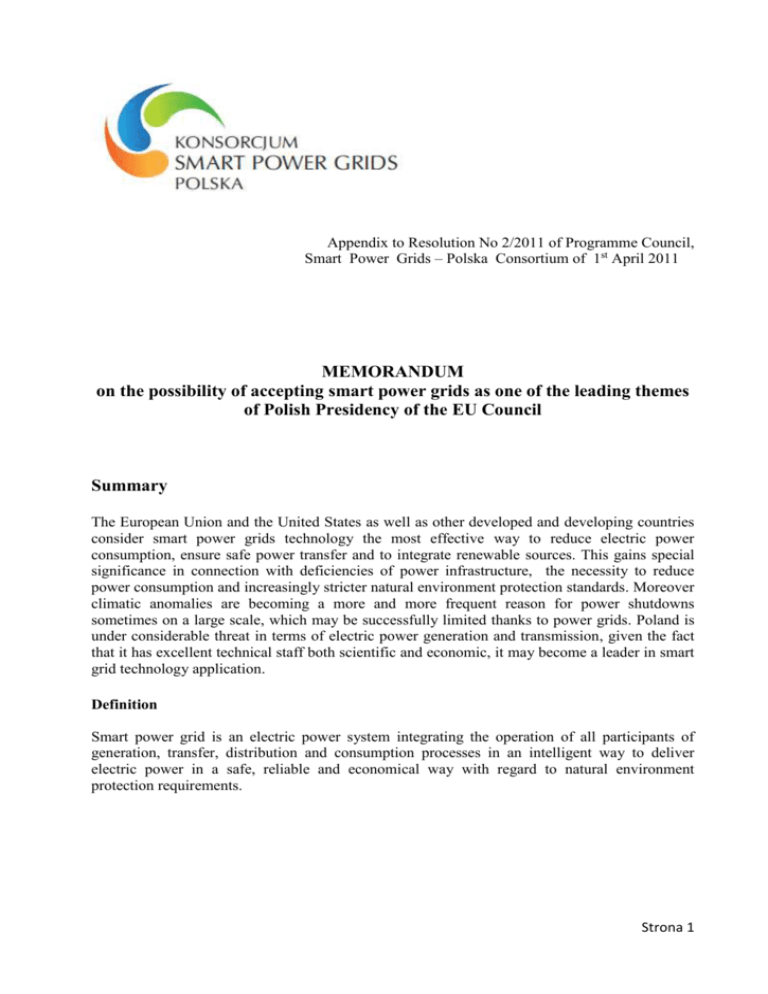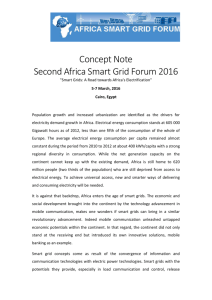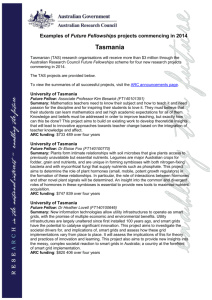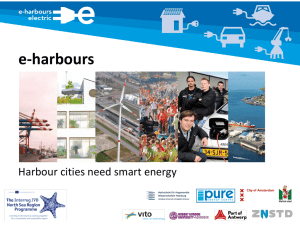Załącznik - Smart Power Grids Polska
advertisement

Appendix to Resolution No 2/2011 of Programme Council, Smart Power Grids – Polska Consortium of 1st April 2011 MEMORANDUM on the possibility of accepting smart power grids as one of the leading themes of Polish Presidency of the EU Council Summary The European Union and the United States as well as other developed and developing countries consider smart power grids technology the most effective way to reduce electric power consumption, ensure safe power transfer and to integrate renewable sources. This gains special significance in connection with deficiencies of power infrastructure, the necessity to reduce power consumption and increasingly stricter natural environment protection standards. Moreover climatic anomalies are becoming a more and more frequent reason for power shutdowns sometimes on a large scale, which may be successfully limited thanks to power grids. Poland is under considerable threat in terms of electric power generation and transmission, given the fact that it has excellent technical staff both scientific and economic, it may become a leader in smart grid technology application. Definition Smart power grid is an electric power system integrating the operation of all participants of generation, transfer, distribution and consumption processes in an intelligent way to deliver electric power in a safe, reliable and economical way with regard to natural environment protection requirements. Strona 1 A. Social, economic and political reasons justifying the choice of the theme of smart power grids technology 1. Poland as well as the whole Europe and the rest of the world are becoming more and more dependent on electrical power which in consequence leads to the necessity to ensure electrical energy security and sustainable economic growth. 2. Polish electrical power engineering industry and Polish society must pay the highest price – among the EU member states – for the ambitious EU politics related to reducing the environmental and climatic consequences of greenhouse and industrial gases emission resulting from fossil fuels combustion. In negotiations with the UE the government of the Republic of Poland must adopt a hard stance in this respect. This is why giving the matter of smart grid technology priority status during the Polish presidency will show our openness to changes, innovations and technologies of the future. 3. The deficiencies of power infrastructure occur more and more commonly not only in Poland but also in all EU member states. According to EY reports in the period of the next 20 years the minimum 50 thousand km of power grids should be built or at least modernised. Due to environmental reasons it will not be possible to do it. Thus smart power grids become an alternative which can complete infrastructure investments. 4. Challenges faced by electrical power systems are connected with the increasing need for electric power, problems with distributed generation from renewable sources and consumer needs (e.g. electric cars), they are all shared by Poland and the whole Europe. 5. The issue of smart grid in the world is perceived as a way to solve a large part of problems related to the generation, transfer and distribution of electric power in the perspective of the next 10 – 20 years. 6. The smart grids technology is to give strong support for the EU politics related to electric power engineering (EPE) encompassed in the Energy and Climate Packet and the politics pertaining to III Liberation Packet. 7. Poland offers very well educated engineering and electrical power staff as well as specialists in the fields of telecommunication and computer science, and these disciplines are the basis of the smart grid technology. B. Current situation in the light of the Europe 2020 strategy 1. Electric power demand is annually increasing by 2%, which means that in the next 20 years the demand will grow by about 50%. This growth may be much bigger if we take into account the needs related to the mass use of electric vehicles. 2. The existing power infrastructure is obsolete because most of it was built some 30 – 50 years ago and the power demand increase is twice as fast as infrastructure development. Strona 2 3. Energy generation and transfer must take into account environment protection requirements, thus the construction of new grids is becoming more difficult (legal regulations) and the needs to save energy are urgent. 4. Fast growth of renewable energy share (20% renewable energy in energy balance and 20% reduction of greenhouse gas emission until 2020 in the UE) causes problems related to the integration of renewable electrical energy sources (including wind farms) with the electrical power system. 5. Power losses on transmission and distribution grids reach up to 6 – 9% of the generated power. If we take into account power plant and substation’s own needs which reach up to 10% of the generated power, it turns out that the electrical power system is the largest consumer of the generated power and uses nearly 1/5 of all energy. 6. Consumer needs related to power costs, power quality, supply reliability and the right to choose a supplier must be taken into account. 7. According to the EU requirements, the increase in the effectiveness of power consumption should be 20% in the next 10 years. 8. There are more and more serious consequences of disturbances in the operation of electrical power systems which is related mainly to the growing overload of network elements. 9. There is growing threat of electrical power systems failures (blackouts) which is the consequence of more and more frequent natural disasters (global warming), terrorism and insufficient coordination of controls and safety. C. Opportunities offered by smart grids technology 1. Intelligent measurement systems, owing to smart meters supplied to consumers allow for a two way communication and bring the following benefits: Thanks to informed decisions of industrial and municipal customers receiving current information (demand management) there will be balanced daily loads and a decrease in the total power consumption. Balanced daily loads will contribute to the decrease in transfer losses and power consumption for the needs of power plants. Moreover this process will reduce peak loads of electric power system elements and thus the increase the safety of power transfer. It will be possible to use automatic billing of the actual electric power consumption and automatic invoicing. 2. Smart operational measurements will ensure the possibility to observe transfer and distribution systems states and thanks to this allow: to use dynamic loads of electric power grids adjusting them to the existing climatic conditions, Strona 3 to undertake preventive measures in the situations when system stability margin is too small, conscious reactions of dispatchers aimed at preventing the distribution of disturbances in system operation, current simulations predicting system reaction to new situations (overloads, short circuit, switching off grids, etc.), optimum integration of distributed generation sources – in particular wind energy sources – with the electric power systems. 3. Intelligent controls and safety in electric power systems will bring the following benefits: Elimination of damaged system elements will be easy, reliable and selective thanks to intelligent safety algorithms, Controlling active and passive power generation will be adjusted to the current demand and situation both in normal and failure states, Optimisation of transfer capacity will be achieved through intelligent control of the FACTS systems, transverse regulation of transformer voltage and adaptation compensation of passive power, Increase in electric power transfer safety and distribution as the consequences of failures are limited and catastrophic blackouts are eliminated. 4. Intelligent algorithms of post-failure restoration ensure quick and precise localisation of faults and selection of the best restoration strategy. 5. Intelligent creation of autonomous electric power systems will results in the creation of subsystems which are locally balanced and able to carry out island operation which will increase the power supply safety at the time of blackouts. D. Application of smart grids technology in Poland 1. Electric power grids require enormous investments and the implementation of the smart grids technology will allow for optimum use of distribution and transfer networks. 2. Poland has a unique opportunity to avoid the mistakes made by other countries and to implement intelligent network solutions before the mass connection to distributed energy sources to the power system of our country. 3. It is necessary to prepare a development and standardisation concept of smart grids and to create control optimisation tools for power grids as well as accept safety standards for the data collected by smart grids. 4. The operators of distribution systems have started pilot implementation of tens of thousands smart meters while the market need in Poland would be more than ten millions of such smart meters. Such activities are wrongly considered the implementation of smart grids technology. It is necessary to start wider education and information activity targeted at politicians, economic and regional government activists as well as power consumers. A Strona 4 good example of such activity is a postgraduate smart grids course at the Wrocław University of Technology. 5. Manufacturers of smart meters have technical facilities allowing them to start mass production of the equipment and software for smart grids. Moreover Polish industrial plants produce modern safety and control equipment. 6. In Poland there have been many initiatives related to smart grids technology. One should mention here: Smart Power Grids Consortium – Polska whose leader is Wrocław University of Technology), National Technology Power Platform, faculties of electrical engineering at AGH University of Science and Technology in Krakow, Opole University of Technology, Warsaw University of Technology and Technical University of Lodz and many others. 7. One of the strengths of Polish economy is the innovativeness of its research centres (universities, research institutes and equipment manufacturers) related to new, patent confirmed telecommunication solutions and safety and control systems. Strona 5







